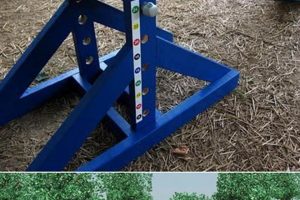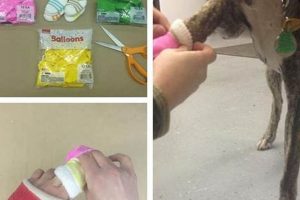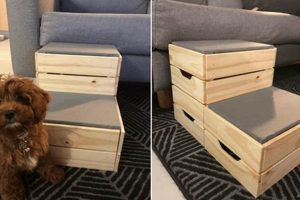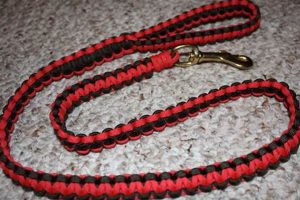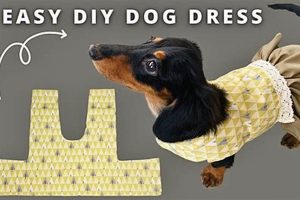Homemade canine footwear offers a practical solution for protecting a dog’s paws from various environmental hazards. These items, constructed from readily available materials, provide a barrier against extreme temperatures, rough terrains, and potentially harmful substances. For example, simple fabric booties can shield paws from hot pavement during summer or icy conditions in winter.
The significance of such protective wear lies in its ability to prevent injuries and discomfort in dogs. Benefits include reduced risk of burns, cuts, abrasions, and exposure to allergens or irritants. Historically, owners have improvised coverings for their working dogs’ feet; this approach offers cost-effective and customizable options for addressing specific needs and circumstances. Such projects allow for tailored solutions where commercially available products may not be suitable.
The subsequent sections will address material selection, construction techniques, and fitting guidelines to facilitate the creation of effective and appropriate coverings for a dog’s paws. These considerations are essential for ensuring both the functionality and safety of any designed protective wear.
Tips for Creating Canine Footwear
The creation of effective canine footwear requires careful consideration of material, construction, and fit. Adherence to the following guidelines will improve the quality and practicality of resulting paw protection.
Tip 1: Material Selection. Choose durable, breathable fabrics suitable for the intended use. Heavy canvas, ripstop nylon, or fleece offer varying levels of protection and comfort. Avoid materials that may cause chafing or allergic reactions.
Tip 2: Accurate Measurement. Obtain precise paw measurements to ensure a secure and comfortable fit. Measure both the length and width of the paw while the dog is standing, and add a small allowance for movement.
Tip 3: Secure Fastening. Implement a reliable fastening system, such as Velcro straps or elastic closures, to keep the footwear securely in place. Ensure that the fasteners do not restrict circulation or cause irritation.
Tip 4: Durable Construction. Reinforce seams and stress points with strong stitching to prevent tearing or separation during use. Consider using a heavy-duty thread and a reinforcing fabric for added durability.
Tip 5: Weather Resistance. For wet or snowy conditions, utilize water-resistant or waterproof materials. Applying a sealant to the finished product can further enhance its weather resistance.
Tip 6: Gradual Acclimation. Introduce the footwear to the dog gradually to allow for acclimation. Start with short periods of wear in a controlled environment, and gradually increase the duration as the dog becomes more comfortable.
Tip 7: Regular Inspection. Routinely inspect the footwear for signs of wear and tear, and make necessary repairs or replacements. Check for any signs of irritation or discomfort on the dog’s paws.
By following these tips, owners can create functional and comfortable canine footwear that provides adequate protection from environmental hazards. The benefits include improved paw health, reduced risk of injury, and increased comfort for the dog.
The concluding section will offer guidance on maintenance and long-term care, ensuring optimal performance and longevity of the homemade canine footwear.
1. Material Durability
Material durability is a critical determinant of the efficacy and longevity of homemade canine footwear. The selection of robust materials directly influences the degree of protection afforded to the dog’s paws, as well as the lifespan of the footwear itself. For instance, using a lightweight, easily torn fabric will result in footwear that quickly degrades upon contact with rough terrain, providing minimal safeguarding against abrasions or punctures. Conversely, utilizing a tightly woven, abrasion-resistant material such as heavy canvas or ballistic nylon significantly extends the usability of the footwear and offers a superior barrier against environmental hazards like sharp rocks, hot pavement, or icy conditions. The direct correlation between material quality and protective capability underscores the importance of careful material selection.
The practical implications of prioritizing material durability extend beyond mere cost-effectiveness. While initially more expensive, durable materials ultimately prove more economical by reducing the frequency of replacements. Furthermore, the enhanced performance of robust materials contributes to the overall well-being of the dog. Footwear that resists tearing or degradation minimizes the risk of paw injuries, preventing discomfort and potential veterinary expenses. For example, a dog wearing shoes constructed from durable, water-resistant material is less likely to develop frostbite or suffer from paw pad damage during winter excursions. Similarly, footwear made from breathable, yet strong, fabric helps prevent overheating and excessive sweating in warmer climates.
In summary, the choice of material is a fundamental aspect of crafting effective homemade canine footwear. Opting for durable materials ensures adequate protection, prolongs the lifespan of the footwear, and ultimately promotes the health and comfort of the dog. While challenges may arise in sourcing appropriate materials or mastering construction techniques, the long-term benefits of prioritizing durability far outweigh the initial investment of time and resources. The selection of appropriate and lasting material is a key factor in successful paw protection.
2. Accurate Paw Measurement
Precise paw measurements are paramount to the successful design and function of homemade canine footwear. Without accurate dimensions, the resulting shoes are unlikely to provide adequate protection or remain securely in place during activity. The implications of inaccurate measurements range from discomfort and potential injury to complete ineffectiveness of the protective gear.
- Prevention of Chafing and Blisters
Footwear that is too tight restricts circulation and causes friction, leading to chafing and the formation of blisters on the dog’s paws. Precise measurements ensure sufficient room for the paw to move without excessive rubbing. For instance, a shoe that is only slightly too small can cause significant irritation during a long walk, rendering the footwear counterproductive.
- Ensuring Secure Fit
Conversely, footwear that is too large is prone to slipping and sliding, which can be both irritating and dangerous. A loose-fitting shoe may easily come off during physical activity, exposing the paw to potential hazards. Accurate measurements allow for a snug but comfortable fit that minimizes the risk of displacement while maintaining freedom of movement. A well-fitting shoe should stay in place without requiring overly tight fasteners.
- Accommodation for Paw Shape and Size Variations
Dogs’ paws exhibit considerable variation in shape and size, even within the same breed. Standardized sizing in commercially available footwear may not adequately accommodate these differences. Accurate measurements allow for custom adjustments to address specific anatomical features, such as wide paws, long nails, or uneven toe lengths. This individualized approach is critical for ensuring optimal comfort and protection.
- Facilitating Proper Design and Construction
Precise measurements serve as the foundation for creating accurate patterns and ensuring correct assembly of the footwear. A detailed understanding of the paw’s dimensions, including length, width, and circumference, enables the construction of a shoe that conforms precisely to the dog’s foot. This level of precision is essential for achieving a professional-quality finish and maximizing the functionality of the homemade footwear.
In conclusion, meticulous paw measurement is not merely a preliminary step but an integral component of the entire homemade canine footwear process. The accuracy of these measurements directly influences the comfort, security, and protective capabilities of the finished product. While alternative methods might offer approximate dimensions, precise data collection ensures the resulting footwear meets the unique needs and characteristics of the dog’s paws, ultimately contributing to enhanced well-being and performance.
3. Secure Fastening System
A reliable secure fastening system is integral to the functionality of do-it-yourself (DIY) canine footwear. Without an effective closure mechanism, even the most well-constructed shoe will fail to provide adequate protection or stay affixed to the dog’s paw during activity. The following considerations highlight the importance of a secure fastening system in the context of homemade dog shoes.
- Prevention of Shoe Loss
The primary function of a secure fastening system is to prevent the shoe from falling off the dog’s paw. Loose-fitting shoes not only fail to protect the paw but also present a tripping hazard. A robust fastening mechanism, such as adjustable straps or hook-and-loop closures, ensures the shoe remains in place during various activities, including walking, running, and playing. For instance, a dog traversing rough terrain requires footwear that remains securely attached to prevent injury from exposed rocks or debris.
- Distribution of Pressure and Minimization of Discomfort
A well-designed fastening system distributes pressure evenly across the dog’s paw and ankle, preventing localized areas of discomfort or irritation. Overly tight straps can restrict circulation and cause chafing, while loose fasteners offer inadequate support. The fastening system should be adjustable to accommodate variations in paw size and shape, ensuring a snug yet comfortable fit. Elasticized sections can provide additional flexibility and reduce pressure points.
- Adaptability to Various Paw and Leg Conformations
Dogs exhibit a wide range of paw and leg conformations, requiring fastening systems that can be adapted to individual anatomical differences. Some dogs have thick fur around their ankles, while others have more slender legs. The fastening system should be versatile enough to accommodate these variations without compromising security or comfort. Adjustable straps, elastic closures, and multiple fastening points enable customization for a secure and comfortable fit on a diverse range of canine anatomies.
- Ease of Application and Removal
While security is paramount, the fastening system should also be relatively easy for the owner to apply and remove. Complicated or cumbersome closures can be frustrating for both the owner and the dog, reducing the likelihood of consistent use. Simple, intuitive designs, such as hook-and-loop closures or quick-release buckles, facilitate efficient application and removal without sacrificing security. The fastening system should also be durable enough to withstand repeated use without losing its effectiveness.
In summation, a secure fastening system is a critical component of effective DIY dog shoes, influencing their ability to stay in place, distribute pressure evenly, accommodate diverse paw shapes, and facilitate ease of use. Neglecting this aspect of shoe design can compromise the protective capabilities of the footwear and reduce the likelihood of the dog accepting and tolerating its use. The careful selection and implementation of a robust and adaptable fastening system is essential for ensuring the success of homemade canine footwear.
4. Weather Resistance
Weather resistance is a critical attribute of effective homemade canine footwear. The absence of this feature renders such items largely unsuitable for use in a variety of common environmental conditions, thereby negating their primary purpose. The degree to which homemade shoes can withstand exposure to moisture, extreme temperatures, and abrasive surfaces directly impacts their protective capabilities and longevity.
Consider the effect of moisture penetration on unprotected paws. Prolonged exposure to rain or snow can lead to dermatological issues, such as dermatitis or fungal infections. In cold climates, saturated footwear exacerbates the risk of frostbite and tissue damage. Therefore, utilizing water-resistant or waterproof materials in the construction of the shoes becomes essential. Similarly, the soles of the shoes must be able to withstand the abrasive effects of asphalt, ice, or rocky terrain. Materials that degrade rapidly under such conditions offer minimal protection and require frequent replacement. For instance, a shoe constructed from non-weather-resistant fabric will quickly become soaked in wet conditions, offering no insulation against the cold and potentially causing discomfort or injury.
The practical significance of weather resistance extends to the overall usability of homemade canine footwear. Shoes that can effectively withstand diverse weather conditions provide consistent protection and allow dogs to engage in outdoor activities regardless of the prevailing environment. This contributes to the dog’s well-being by enabling regular exercise and reducing the risk of weather-related health problems. While achieving complete weatherproofing in DIY projects may present challenges, the incorporation of appropriate materials and construction techniques significantly enhances the protective capabilities of the footwear. Durable, weather-resistant shoes represent a proactive measure in safeguarding canine health and promoting an active lifestyle.
5. Comfort and Fit
The interplay of comfort and fit is crucial to the success and acceptance of homemade canine footwear. A poorly fitting shoe, regardless of its protective qualities, is likely to be rejected by the dog, rendering the effort of its creation futile. Achieving optimal comfort and fit necessitates careful attention to several interrelated factors.
- Proper Sizing and Shape
Accurate measurement of the dog’s paws is fundamental. Length, width, and circumference must be considered to create a shoe that conforms to the paw’s natural shape without constricting movement. A shoe that is too tight can cause chafing and restrict circulation, while one that is too loose may slip off or impede gait. For instance, a shoe designed without sufficient width may compress the toes, leading to discomfort and potential injury.
- Material Selection for Breathability and Flexibility
The choice of materials influences both comfort and durability. Breathable fabrics, such as cotton or specialized synthetic blends, allow for adequate ventilation, preventing moisture buildup and reducing the risk of skin irritation. Flexible materials, like softshell fabrics, permit natural movement and reduce stiffness. Conversely, rigid or non-breathable materials can create pressure points and cause overheating. A shoe constructed from stiff leather, for example, may cause discomfort and restrict the dog’s natural stride.
- Secure and Adjustable Fastening Systems
A secure fastening system is necessary to keep the shoe in place, but it must also be adjustable to accommodate variations in paw size and shape. Straps or closures that are too tight can restrict circulation and cause discomfort, while those that are too loose may allow the shoe to slip off. Hook-and-loop fasteners or elastic closures offer adjustability and can be customized to provide a snug yet comfortable fit. A shoe with poorly designed straps might rub against the dog’s leg, causing irritation and hindering acceptance.
- Gradual Acclimation and Positive Reinforcement
Even with a well-fitting and comfortable shoe, dogs may initially resist wearing footwear. Gradual acclimation is essential to help the dog adjust to the sensation of wearing shoes. Starting with short periods of wear in a familiar environment and using positive reinforcement, such as treats and praise, can encourage acceptance. Forcing a dog to wear uncomfortable or unfamiliar footwear is likely to result in resistance and aversion. An incremental introduction to the shoes, coupled with positive associations, fosters a more positive experience.
In summary, comfort and fit are inextricably linked to the success of homemade canine footwear. These elements, informed by precise measurements, judicious material selection, secure fastening, and patient acclimation, determine whether the shoes will be tolerated and effective. Prioritizing comfort and fit is essential for ensuring that the footwear provides genuine protection and enhances the dog’s well-being, rather than causing discomfort or distress.
6. Construction Method
The construction method employed in the creation of do-it-yourself (DIY) canine footwear profoundly influences the durability, fit, and overall effectiveness of the finished product. A well-executed construction method translates directly into enhanced protection and comfort for the animal, while conversely, a poorly implemented approach can negate the benefits of even the highest quality materials.
- Seam Integrity and Reinforcement
The manner in which seams are constructed and reinforced directly impacts the structural integrity of the shoe. Weak or poorly stitched seams are prone to tearing, particularly under stress, compromising the protective function of the footwear. Employing techniques such as double stitching, serging, or the application of seam tape reinforces these critical junctures, preventing separation and extending the lifespan of the shoe. For example, a shoe designed for rugged terrain requires robust seam construction to withstand abrasion and prevent tearing when encountering sharp rocks or uneven surfaces.
- Pattern Design and Accuracy
The underlying pattern upon which the shoe is based dictates its fit and overall shape. An inaccurate or poorly conceived pattern can result in a shoe that constricts movement, chafes the paw, or fails to stay securely in place. Careful attention to pattern design, informed by precise paw measurements, is essential for achieving a comfortable and functional fit. For instance, a pattern that does not adequately account for the natural curvature of the paw can create pressure points and lead to discomfort.
- Attachment of Soles and Reinforcements
The method used to attach the sole to the upper portion of the shoe significantly influences its durability and water resistance. Glued soles are often less durable and prone to separation, particularly in wet conditions, whereas stitched or bonded soles offer greater longevity and protection. Similarly, the incorporation of reinforcements, such as toe caps or heel counters, enhances the shoe’s resistance to abrasion and impact. A shoe designed for winter use, for example, benefits from a securely attached, waterproof sole and insulated reinforcements to protect against cold and moisture.
- Material Compatibility and Layering
The selection and layering of materials must be carefully considered to ensure compatibility and optimal performance. Combining materials with incompatible properties can lead to premature wear, reduced breathability, or compromised water resistance. For example, layering a non-breathable lining material beneath a waterproof outer layer can trap moisture and lead to discomfort. The construction method should prioritize the harmonious integration of materials to maximize their individual benefits and create a durable, comfortable, and protective shoe.
In summary, the construction method is not merely a technical detail but a fundamental determinant of the success or failure of DIY canine footwear. By prioritizing robust seam construction, accurate pattern design, secure sole attachment, and harmonious material layering, creators can significantly enhance the durability, fit, and protective capabilities of their homemade shoes, ensuring the well-being and comfort of their canine companions.
7. Dog Acclimation
The process of dog acclimation is inextricably linked to the successful utilization of do-it-yourself (DIY) dog shoes. The inherent novelty of footwear for canines often elicits resistance or discomfort, underscoring the necessity for a gradual and positive introduction. The effectiveness of paw protection hinges not solely on the quality of construction or material selection but also on the dog’s willingness to wear the shoes. A forced or abrupt introduction can result in aversion, rendering the DIY footwear useless. The causal relationship is clear: insufficient acclimation directly leads to non-compliance. An instance of a dog developing sores due to improperly introduced booties illustrates the importance of this process.
Acclimation involves several key steps. Initially, simply presenting the shoes to the dog, allowing it to sniff and investigate, initiates the familiarization process. Subsequent steps might include short periods of wearing the shoes indoors, gradually increasing the duration as the dog becomes more comfortable. Positive reinforcement, such as offering treats or praise, is crucial in associating the footwear with positive experiences. Practical application includes observing the dog’s behavior for any signs of discomfort or distress. If resistance is noted, the acclimation process should be slowed or adjusted to address specific concerns. The gradual exposure and positive reinforcement are the core components of this effort.
In conclusion, dog acclimation is not merely an ancillary consideration but an essential component of successful DIY dog shoe implementation. Challenges may arise, such as dogs with heightened sensitivity or pre-existing anxieties. However, by prioritizing a gradual, positive, and observant approach, dog owners can significantly increase the likelihood of their canine companions accepting and benefiting from the protection offered by DIY footwear. The broader theme emphasizes that animal welfare hinges on a considerate and informed approach to introducing novel items or experiences.
Frequently Asked Questions
This section addresses common inquiries and concerns regarding the creation and use of homemade canine footwear. The information provided aims to offer clarity and guidance for owners seeking to protect their dogs’ paws through DIY solutions.
Question 1: What materials are most suitable for crafting durable dog shoes?
Durable options include heavy canvas, ripstop nylon, and repurposed rubber. Material selection hinges on intended use and environmental conditions. Prioritize abrasion resistance and weather protection.
Question 2: How does one accurately measure a dog’s paw for shoe construction?
Place the dog’s paw on a piece of paper and trace its outline. Measure the length and width of the tracing at the widest points. Add a small allowance for sock thickness and movement.
Question 3: What is the most effective method for securing DIY dog shoes to prevent them from falling off?
Adjustable straps, hook-and-loop closures, and elasticized cuffs are viable options. Ensure the fastening system distributes pressure evenly and does not restrict circulation. Multiple attachment points enhance security.
Question 4: How can weather resistance be enhanced in homemade dog shoes?
Employ waterproof or water-resistant materials. Apply a sealant to seams and surfaces. Consider incorporating a waterproof membrane between layers of fabric.
Question 5: How does one acclimate a dog to wearing shoes to ensure acceptance and comfort?
Introduce the shoes gradually, starting with short periods indoors. Use positive reinforcement, such as treats and praise. Monitor the dog’s behavior for signs of discomfort or distress.
Question 6: What are the potential risks associated with improperly fitted or poorly constructed dog shoes?
Risks include chafing, blisters, restricted circulation, and altered gait. Ill-fitting shoes may also pose a tripping hazard. Regular inspection and careful attention to fit are crucial.
The key takeaway from these questions is that careful planning, precise execution, and mindful observation are essential for creating effective and safe DIY dog shoes. Prioritizing the dog’s comfort and well-being is paramount.
The subsequent section will delve into advanced techniques and specialized applications for DIY dog shoes, addressing the needs of dogs with specific medical conditions or unique environmental challenges.
Conclusion
The preceding exploration of DIY dog shoes underscores the complexity inherent in providing effective paw protection. Material selection, accurate sizing, secure fastening, weather resistance, comfort, construction methods, and acclimation protocols each contribute significantly to the ultimate success or failure of such projects. A deficiency in any one of these areas can compromise the well-being of the animal and negate the intended benefits.
Therefore, individuals embarking on the creation of DIY dog shoes should approach the endeavor with diligence, informed by a thorough understanding of canine anatomy, material properties, and construction techniques. Prioritizing the animal’s comfort and safety over expediency or cost savings is paramount. Only through such meticulous attention to detail can one hope to produce canine footwear that genuinely safeguards against environmental hazards and enhances the quality of life for the animal.



